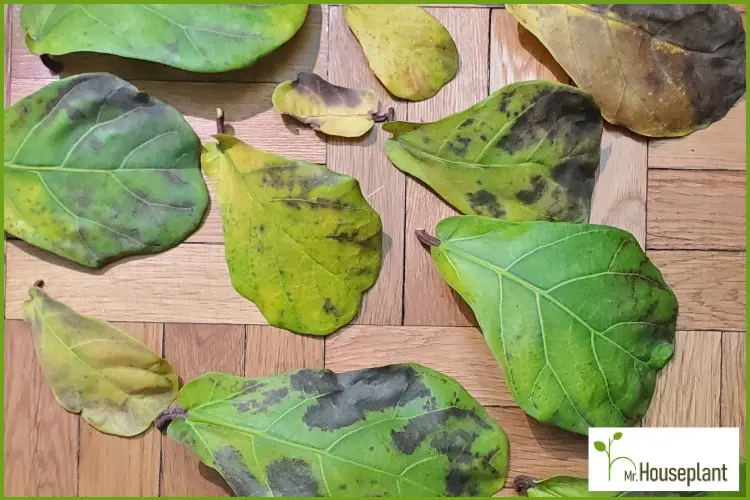
Are you worried about Fiddle Leaf Fig brown spots? You’re wondering what’s causing brown spots, how to identify the cause, and what is the best way to get rid of them? This comprehensive guide covers all of these questions and gives you the necessary knowledge to restore the lush foliage of your Ficus Lyrata.
The causes of brown spots on Fiddle Leaf Fig leaves are:
- Root Rot
- Bacterial Infection
- Underwatering
- Pests
- Physical Damage
- Sunburn
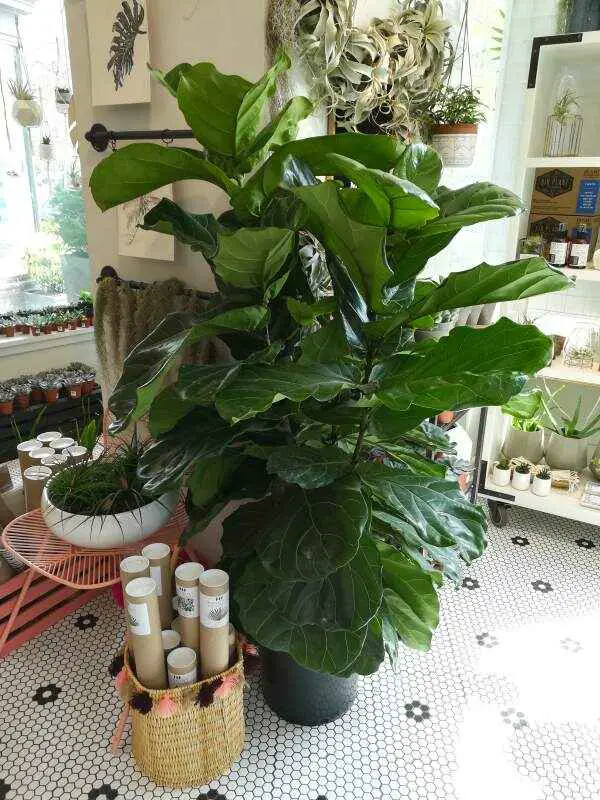
Healthy Ficus Lyrata’s leaves will typically remain dark green
The causes of certain brown spots are easily identifiable. In other cases, several causes might have similar-looking brown spots. In this article, I will provide tricks to help you identify the cause of brown spots.
Brown Spots From Root Rot
Brown spots from root rot are usually very dark brown or black, especially at the base of the leaves and there can also be leaf drop. To determine whether your plant is suffering from root rot, check your plant for the following symptoms: mushy roots, soft roots, and smelly root ball.
How To Treat Root Rot
To treat root rot, the first thing you should do is repot the plant in a well-draining potting mix (2 parts potting soil, 1 part perlite, 1 part bark or another coarse amendment), and in a pot with drainage holes. You will have to prune the affected roots (roots that are soft, smelly, or mushy). You can cut off the brown leaf sections if you don’t like the way they look.
Since root rot is caused by overwatering, which is a consequence of inadequate potting mix, inadequate pot, insufficient light, and watering too frequently, you should address all of these issues as well.
You already addressed the first 2 causes by repotting.
To resolve the issue of insufficient light, ensure your plant gets enough bright indirect light (a minimum of 5,000 lux or 500 foot candles). Since Fiddle Leaf Figs are full sun plants, if you can, provide them with several hours of direct sunlight.
To resolve watering too frequently, in the future, you should water your plant when the soil is dry all the way to the bottom of the pot. To test the soil moisture, use a moisture meter or a chopstick. Stick the chopstick in the soil all the way down, if it comes out fully dry, it’s time to water.
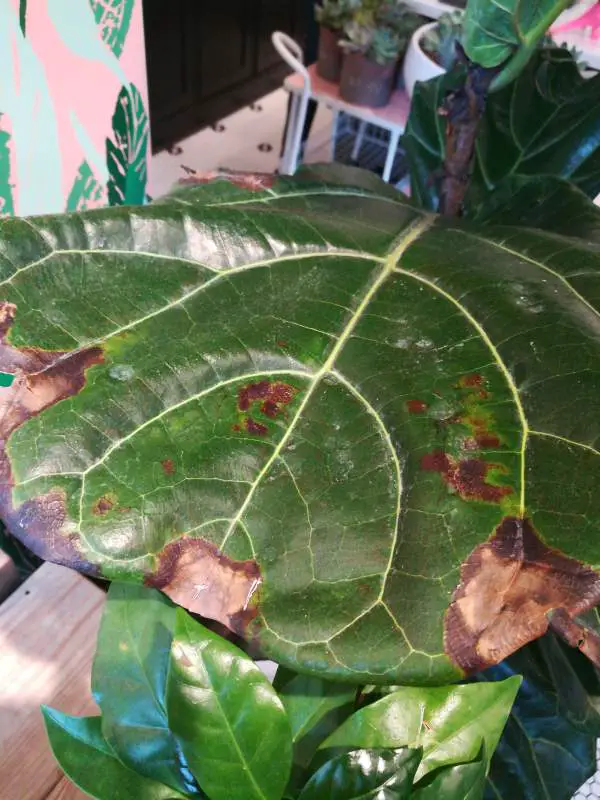
Spots caused by root rot
To learn more details on what causes Ficus Lyrata root rot, what are the signs of this illness, how to treat it, and how to prevent it in Fiddle Leaf Figs, you can check the linked blog post.
Brown Spots From Bacterial Infection
Brown spots from a bacterial infection will usually have water-soaked lessions or slightly swollen areas on the stems or leaf veins.
How To Treat
Bacterial infections are difficult to treat. The best thing you can do is to quickly prune all afflicted leaf areas to prevent the further spreading of the infection. Also make sure to not get the remaining leaves wet, as this can help spread bacterial infection. And put the plant in a place where it will get a lot of direct sunlight and good air circulation.
Brown Spots Caused By Underwatering
Brown spots from underwatering will manifest themselves on the outer leaf edges with a tendency to spread inward. The plant will look droopy and limp, and the soil might start to compact (move away from the sides of the pot). The leaves might also start yellowing.
How to Treat
If the soil has become too dry, the water will run down the sides of the pot, and only the topsoil and the sides will get watered. If you scratch the soil below the surface, you will notice that the soil an inch below the surface is still dry.
If your plant is underwatered, you have 3 options:
- repot your plant and give it new, fresh, and porous soil
- aerate the soil with a chopstick and water the plant several times until the soil is fully moist
- bottom water
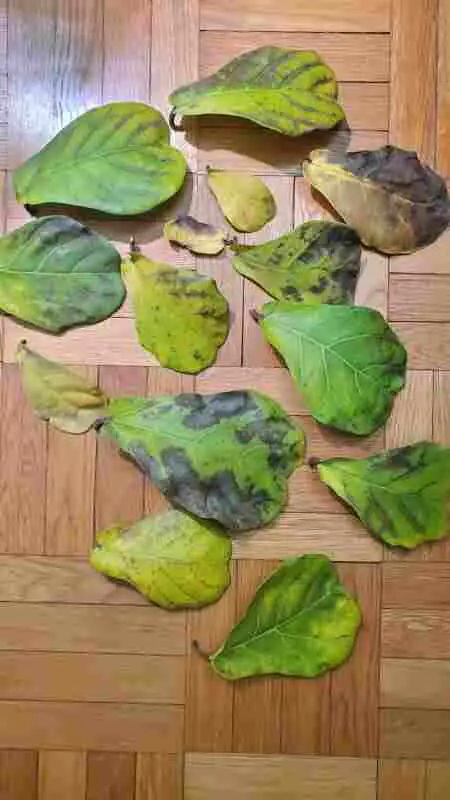
Yellow leaves with dark spots from an underwatered plant
Keep checking the moisture of the soil and adjust the watering frequency accordingly. Adequate watering is vital for a plant’s health, as both underwatering and overwatering can cause damage. You can check out my guide for proper Fiddle Leaf Fig watering.
Brown Spots Caused By Pests
The signs of pest damage on the foliage are small dark spots or small red spots. The insect themselves are often times too small to spot with the naked eye, so you should use a magnifying glass or a macro lens to look for them.
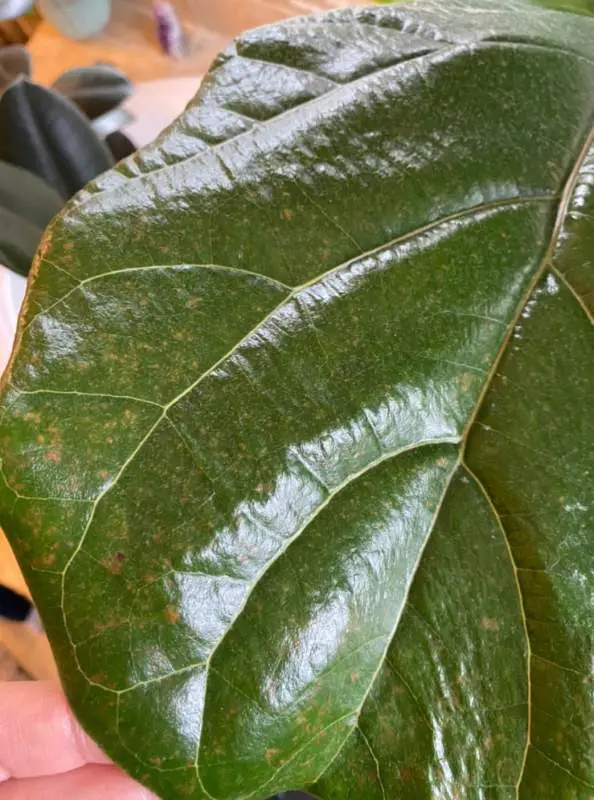
Small dark spots indicate insect damage
How To Treat
To treat your Ficus Lyrata for pests, spray the leaves thoroughly with insecticidal soap, horticultural oil, or neem oil. Spray the topside and the underside of each leaf. Spray 2 to 3 times a week, as some pests have a very short lifecycle and can produce a new generation of offspring in one week.
Also, make sure to separate the plant with pests from the healthy plants, to avoid contamination.
Brown Spots Caused By Physical Damage
Brown spots in combination with cracks and tears can be a consequence of physical damage.
How To Treat
If your plant is otherwise healthy, spots caused by physical damage don’t require any special treatment. The damaged leaf tissue cannot heal and become green again.
Brown Spots Caused By Sunburn
Your plant might get sunburnt if it gets too much direct sunlight without being gradually acclimated to it. Fiddle Leaf Figs are full sun plants. They love direct sunlight. However, if you don’t acclimate them gradually, they can get sunburned. The spots caused by excess direct sunlight will be light brown and will appear on the leaves exposed to direct sunlight.
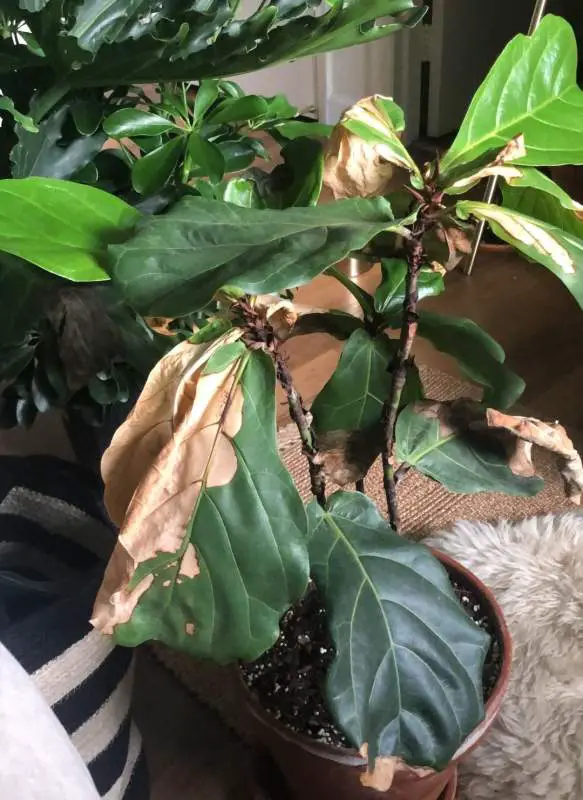
Sunburns will usually be light brown in color
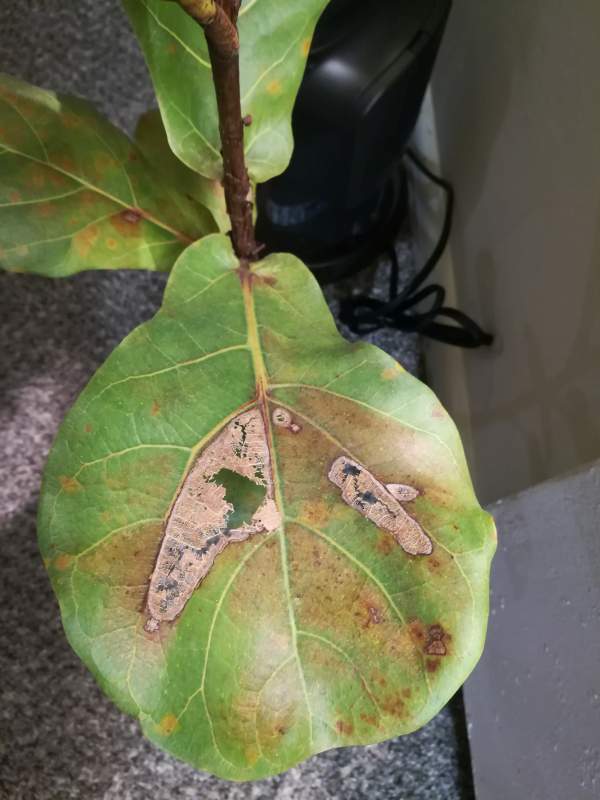
Severe sunburns can even create holes in the leavess
How To Treat
There is no need to treat sunburned leaves as they are only a cosmetic issue. If you don’t like the way they look, take sterilized scissors or pruning shears and cut off the brown parts of the leaves. Then acclimate the plant gradually to direct sunlight.
Check out this useful video-guide o brown spots in Fiddle Leaf Figs:
FAQ
Can You Reverse Brown Spots on Fiddle Leaf Fig
No, you cannot reverse brown spots on Fiddle Leaf Fig. The brown leaf tissue is dead. You can prune the affected tissue, and provide proper environment and care so the plant doesn’t develop new brown spots.
How To Prevent Brown Spots From Forming
The only way to prevent brown spots from forming is to give your plant proper care. Ensure that you’re using a well-draining, porous potting mix and a pot with drainage holes. Acclimate your plant gradually to direct sunlight, and provide proper watering (water once the soil is fully dry). Check your plant regularly so you can react promptly to any signs of distress or pests.
Yours Truly,


Related Posts
Sansevieria Black Gold (Snake Plant Care GUIDE!)
Spathiphyllum Sensation (FULLY Explained!)
Alocasia Stingray Care